Hakka Noodles (Desi Chow Mein)
Hakka Noodles, the Desi version of Chow Mein, are an Indo-Chinese staple. This easy recipe has a bold yet balanced flavor and is ready in less than 40 minutes (including veggie prep). Omit chicken to make it vegetarian. Tested to perfection!
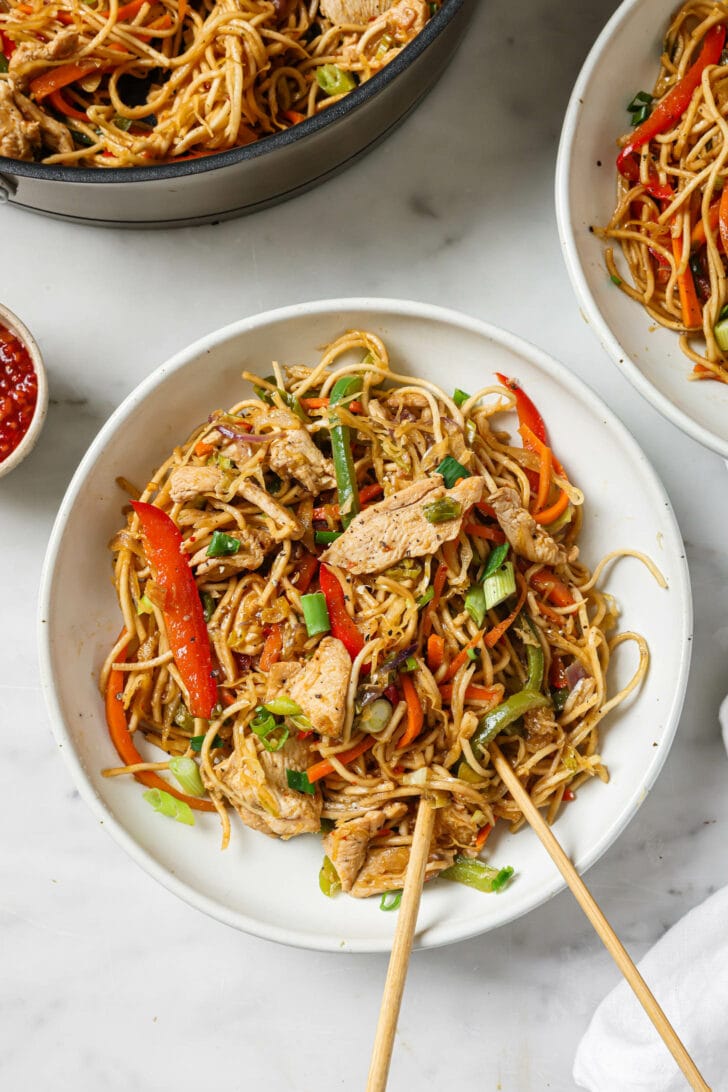
Want to save this post?
Enter your email below and get it sent straight to your inbox. Plus, get recipes & tips every week!
Recipe Testing
For years, I’ve been making an Indo-Chinese version of Nagi’s (RecipeTin Eats) Chow Mein. For my version, I:
- Omit the alcohol for obvious reasons, then compensate for the acidity with rice vinegar
- Replace the bean sprouts and half the cabbage with red onion and bell peppers, and
- Increase the sauce and add chili flakes, chili garlic sauce, and namak mirch (salt & pepper).
Then I had the new recipe tested by eight recipe testers, just for good measure.
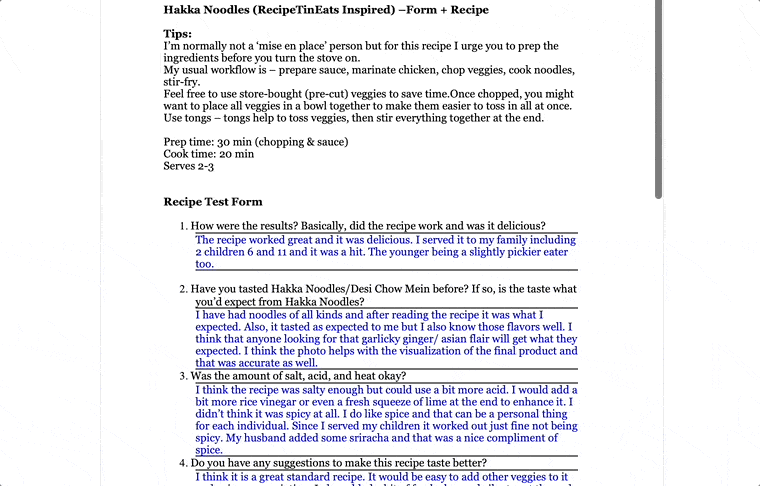
All to bring you this recipe with little room for error, but lots of space for you to adapt it to your own tastes. Plus, you can use whatever noodles, sauces, and vegetables happen to be available to you.
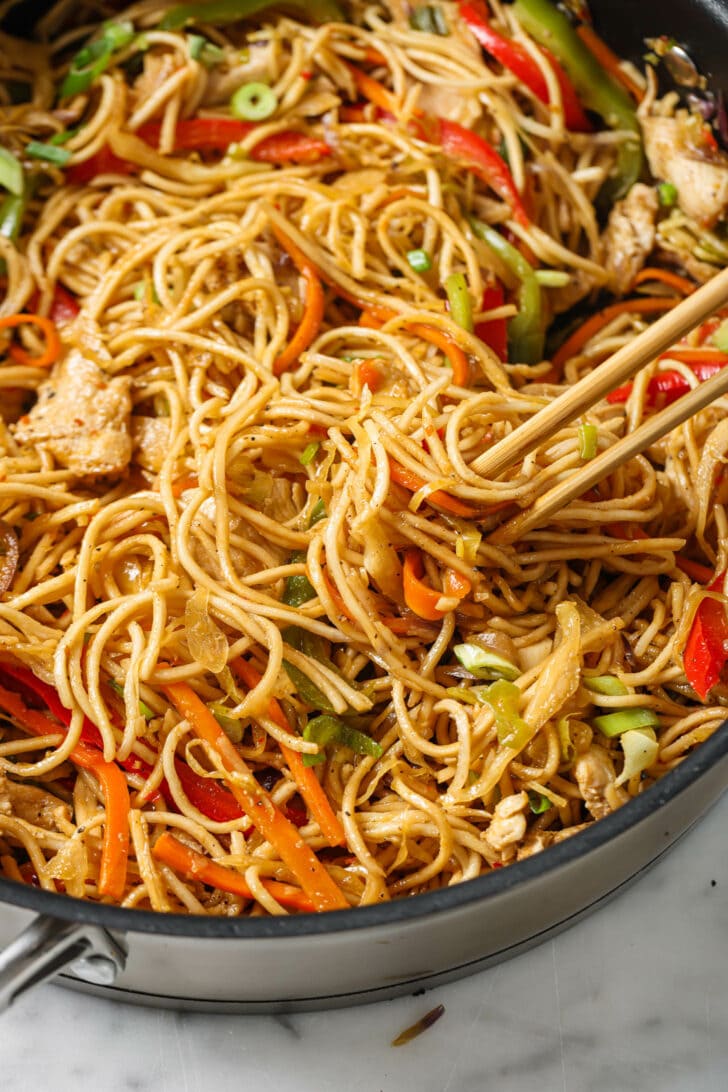
Chow Mein, but Make it Desi
Hakka Noodles are the Indo-Chinese equivalent of Chow Mein. The term “Hakka”, though often used interchangeably with Indo-Chinese, refers to the food of the Hakka people. While these noodles aren’t a part of authentic Hakka cuisine, they are a South Asian adaptation of Hakka.
This version is similar to the ones found in restaurants, though sometimes restaurants keep them simple (i.e. lacking in flavor) to complement other dishes.
More Indo-Chinese Favorites: Chicken Manchurian, Chicken Shashlik, and Cashew Chicken.
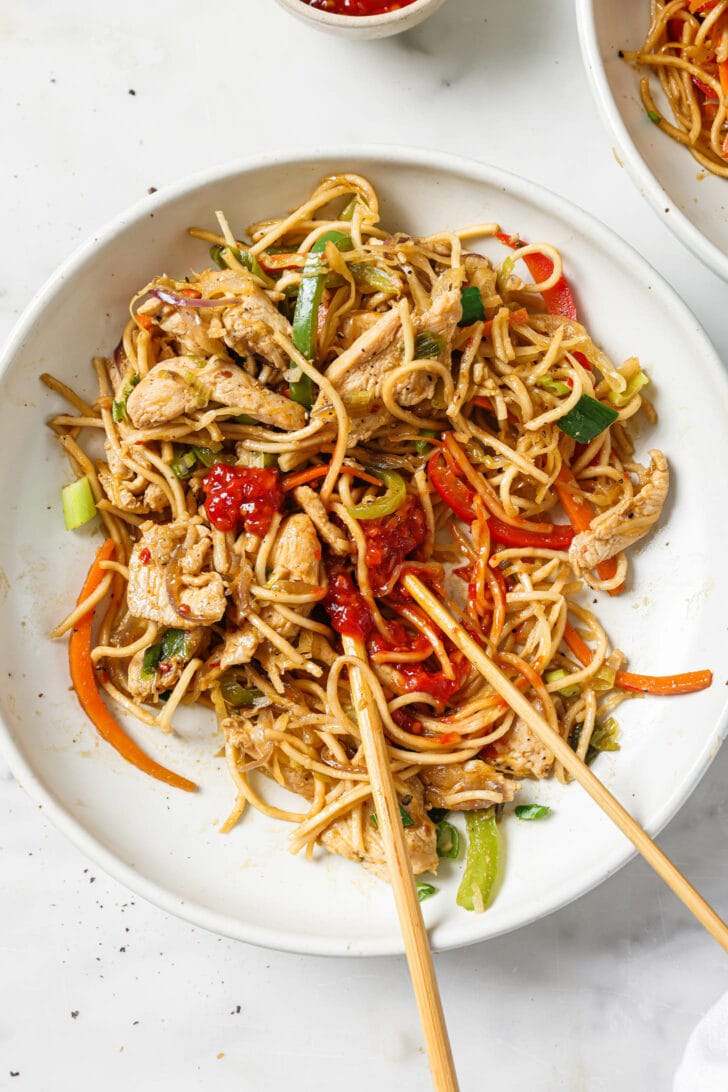
What Noodles to Use for Hakka Noodles
Firstly, you don’t need to use ‘Hakka Noodles’ for this recipe. As you’d expect, specifically labeled Hakka Noodles are hard-to-find and I only see them in Desi stores.
What surprised me was how many people also had a hard time finding Chow Mein noodles.
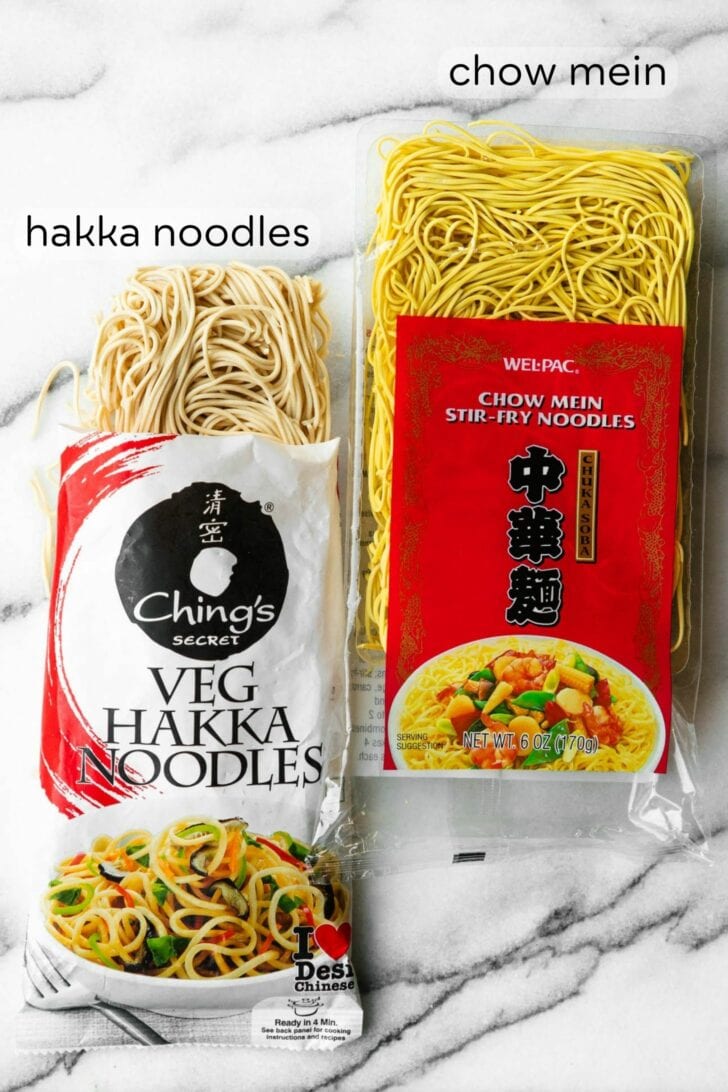
Taking this into account, here’s a summary of your noodle options (hint: they are endless!):
- Ching’s Hakka Noodles: There’s an Egg Hakka and Veg Hakka version (pictured above), marketed specifically for Hakka Noodles. Ching’s also has a ‘just soak’ version (used for the photos) which I find doesn’t last well in the fridge.
- While there’s a slight difference in taste and texture, I wouldn’t say these Hakka noodles are preferable to chow mein, and you certainly don’t need to trek out of your way for them.
- Chow Mein Noodles: I use Wel-Pac (also pictured above), the only one available at my local grocery store. This one has less ingredients – flour, salt, and a bit of color.
- Lo Mein Noodles: Thicker than chow mein, also called Egg noodles.
- ANY noodles: If you’re not able to find any of the above, any thin, dried wheat or egg noodles will work. Yes, even spaghetti (I’d salt the boiling water).
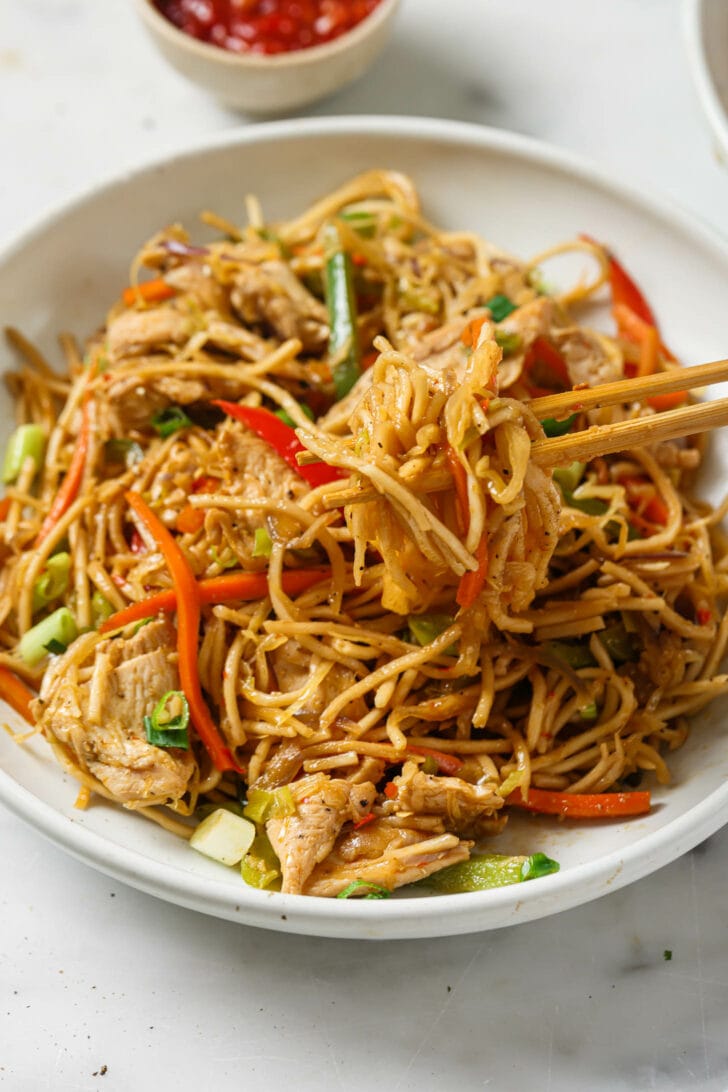
Hakka Noodles Ingredients
Here’s what you’ll need:
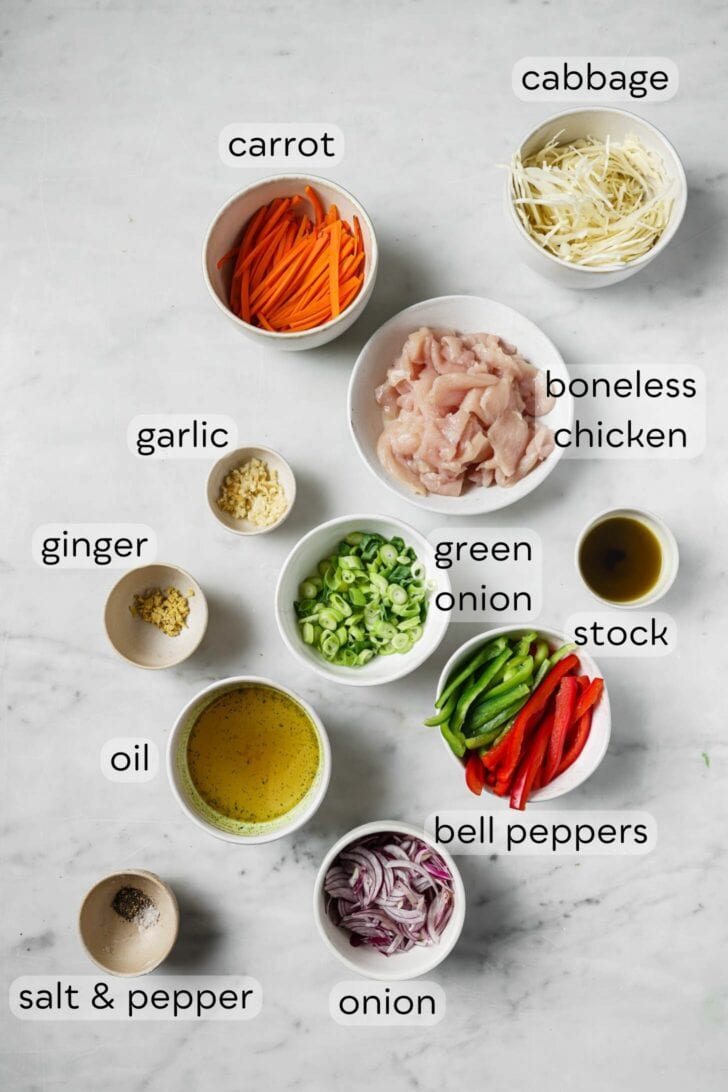
- Chicken breast or thighs: Chop the chicken into bite-sized pieces, about 1/2-inch. Because chicken breast tends to dry out, I’ve given a tenderizing option in the recipe card.
- Neutral oil: The original recipe uses peanut oil, which I replace with my usual grapeseed or avocado.
- Garlic + ginger: Be sure not to crush them using a mortar and pestle, as common in Desi cooking. That would release too much water and make them clumpy, which is fine when they have a safety bed of onions. Here they’re likely to splatter and cook unevenly.
- Green onions: Also called scallions. Use the white and light green parts for cooking and reserve the green parts for garnish.
- Vegetables: I use green cabbage (called white cabbage in the UK), carrot, red onion, and bell peppers. Feel free to use store-bought pre-cut veggies to save time. Once chopped, you might want to place all veggies in a bowl to make them easier to toss in all at once.
- Sea salt: I often use sea salt in my Indo-Chinese recipes because I find it’s closer to the taste of MSG than kosher salt.
- Lime (optional): Upon the suggestion of a couple testers, I tried a squeeze of lime and adored how it livened up the noodles.
Sauce Ingredients
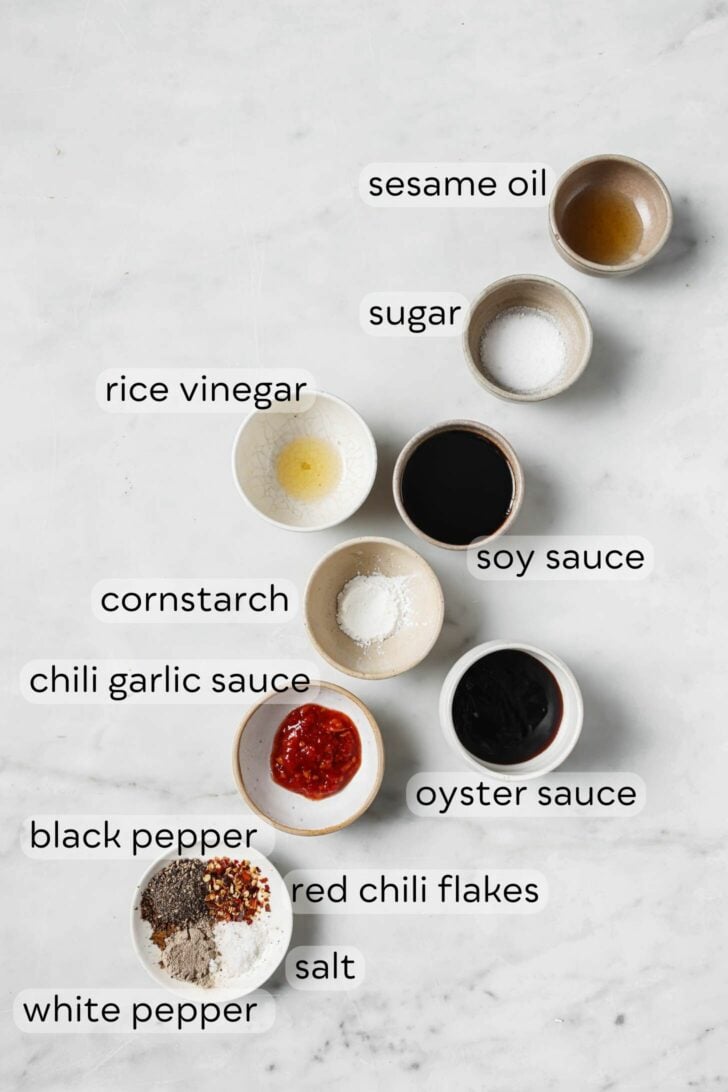
As much as I hope to reach the pinnacle of any particular recipe, I quickly learned from my recipe testers that preferences vary, and that too widely. Some wanted more spice, others less. Some wanted more sauce, others found the stock unnecessary. Here’s what I’ve chosen and why:
- Cornstarch: Used to coat the chicken and thicken the sauce.
- Soy sauce and Oyster Sauce: Your usual Chow Mein ingredients. I increased the amount from the original recipe to increase sauce and give bolder flavor.
- Rice vinegar: Adds acidity to the sauce. I started with 1 tsp and most testers suggested I add more, so I tried again with 1 tbsp and found their suggestion agreeable. Sub with distilled white vinegar.
- Chili garlic sauce: Enhances the tangy, hot, and sweet flavors. Because brands vary in salt, spiciness, and sugar, you’ll have to use your best judgement here. I’ve called for 2 tsp, but up to 1 tbsp is fine for brands like Lee Kum Kee, Huy Fong, and any Indian/Pakistani brands. If you don’t have any on hand, this recipe has enough flavor to do without it.
- Sugar: To balance the heat and acid with hint of sweetness.
- Toasted sesame oil: Adds the distinct, nutty Asian flavor.
- Black pepper: Makes it peppery and pungent.
- Chili flakes: Add warmth and gentle heat.
- White pepper: Enhances the umami flavor and I’d highly recommend using it. If you can’t find it, omit. No need to sub with more black pepper.
- Low-sodium vegetable stock: To add more sauce and flavor. You don’t have to use low-sodium stock, but because the salt in regular stock varies so much, I thought this would be a safer option.
How to make Hakka Noodles
I’m normally not a ‘mise en place’ person but for this recipe I urge you to prep the ingredients before you turn the stove on.
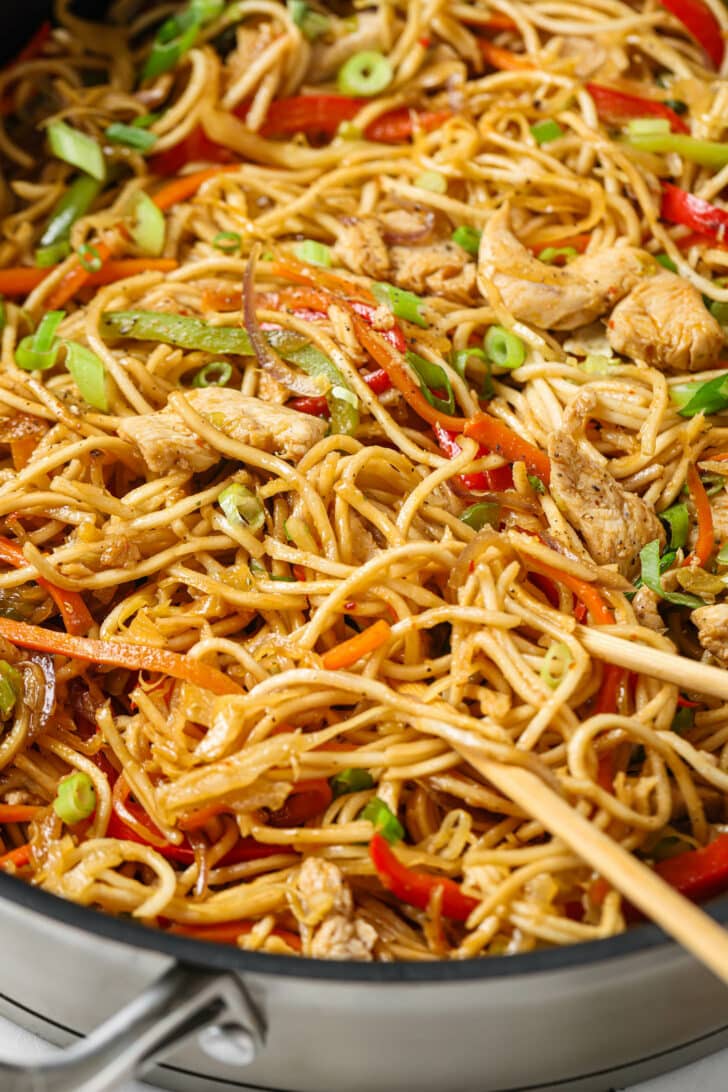
My Usual Workflow:
- prepare sauce
- marinate chicken
- begin boiling water
- chop veggies
- cook noodles in boiling water
- stir-fry
- Make the sauce. Use a couple tablespoons to marinate the chicken and set aside. Obviously it doesn’t hurt to marinate for longer. As I always say, when is marinating a bad idea?
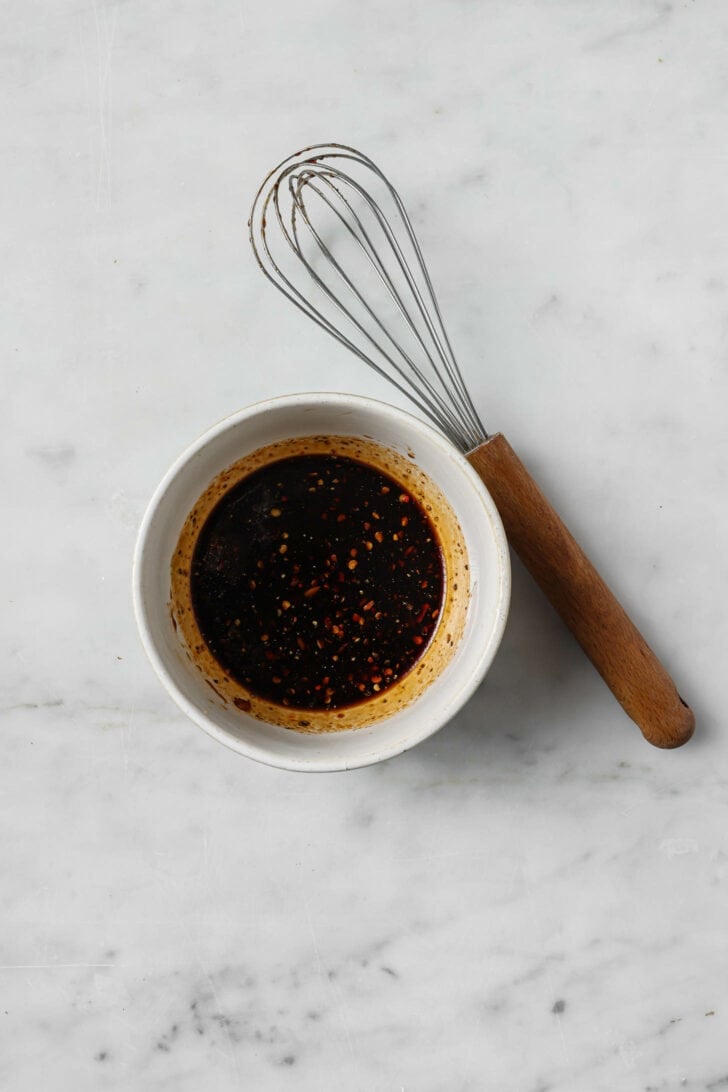
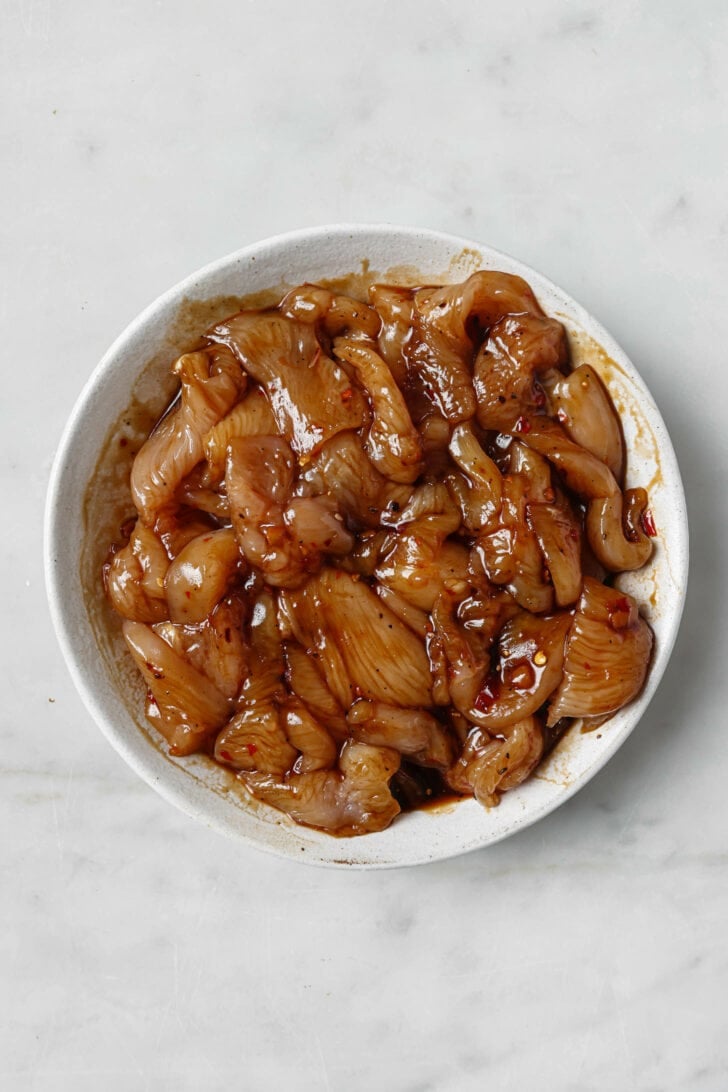
- Heat oil in a large pan or wok. Add garlic and ginger and allow it to take on color without burning or getting bitter. Sauté the chicken but only until it changes from pink to pale. You don’t need to fully cook it here.
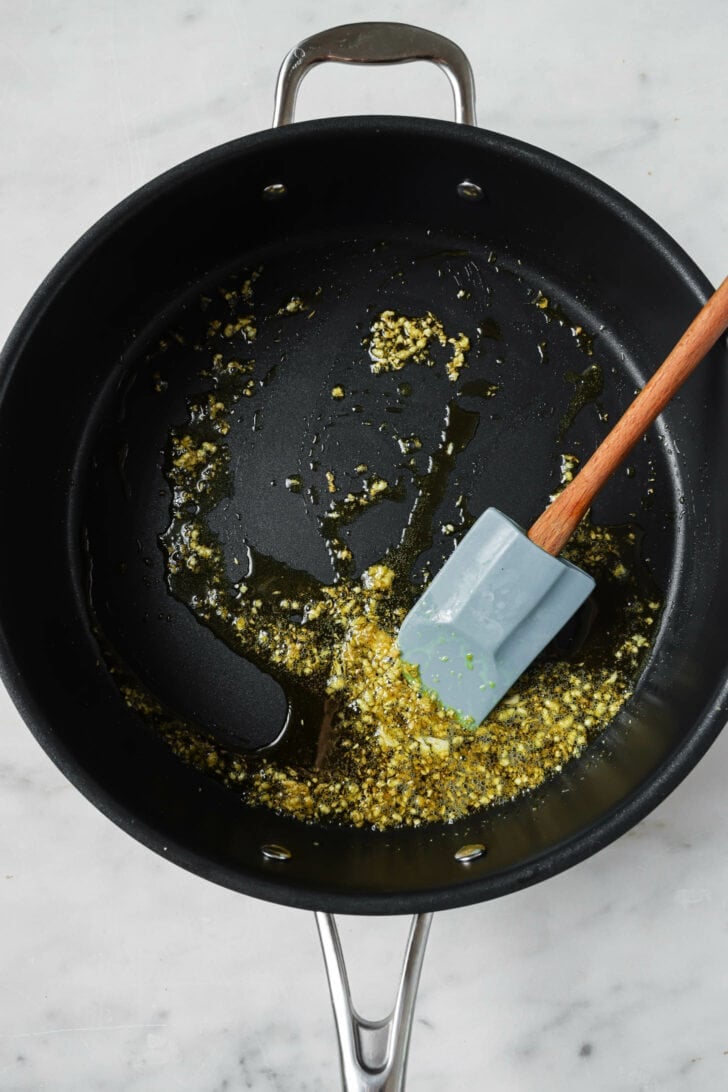
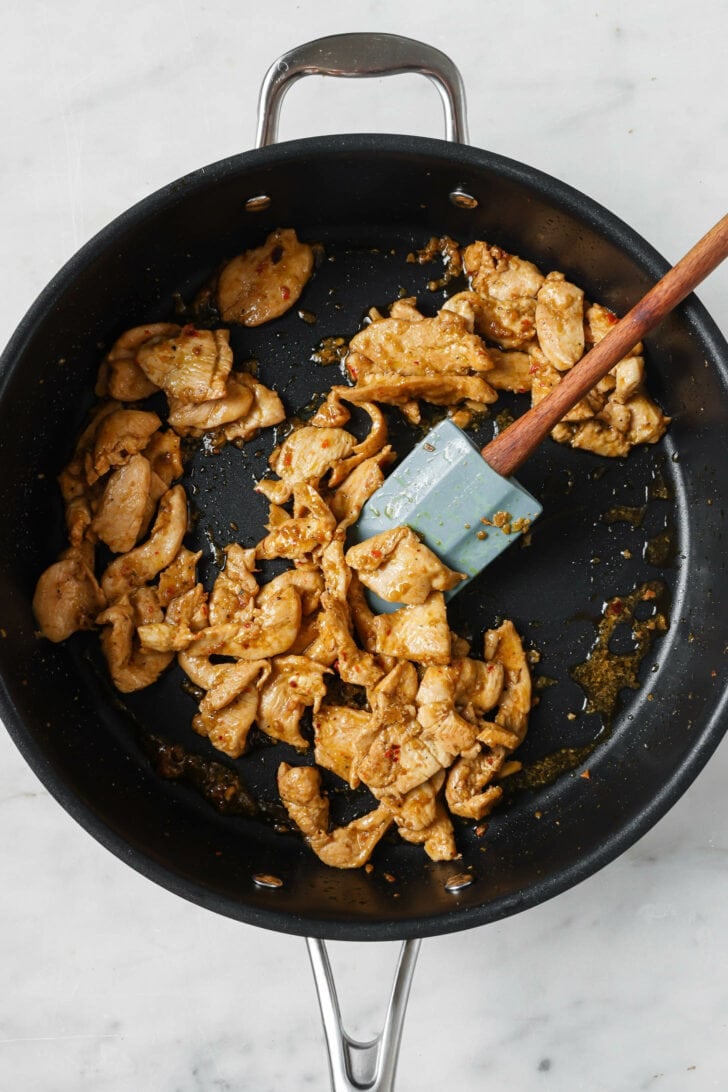
- Toss in the veggies and stir-fry until they’re softened but still crunchy to your liking. Season with a little salt. Sometimes I’ll also add white pepper at this stage.
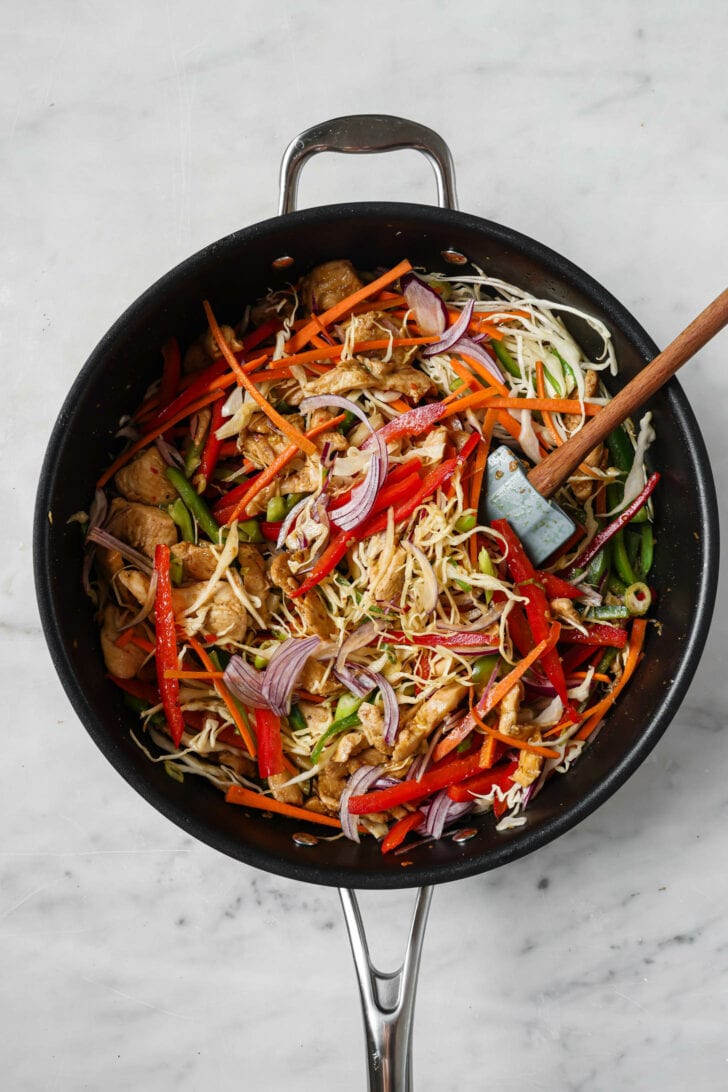
- Add the noodles, sauce, and stock. The reason I add stock separately is because if you add it to the sauce, it’ll weaken the marinade for the chicken.
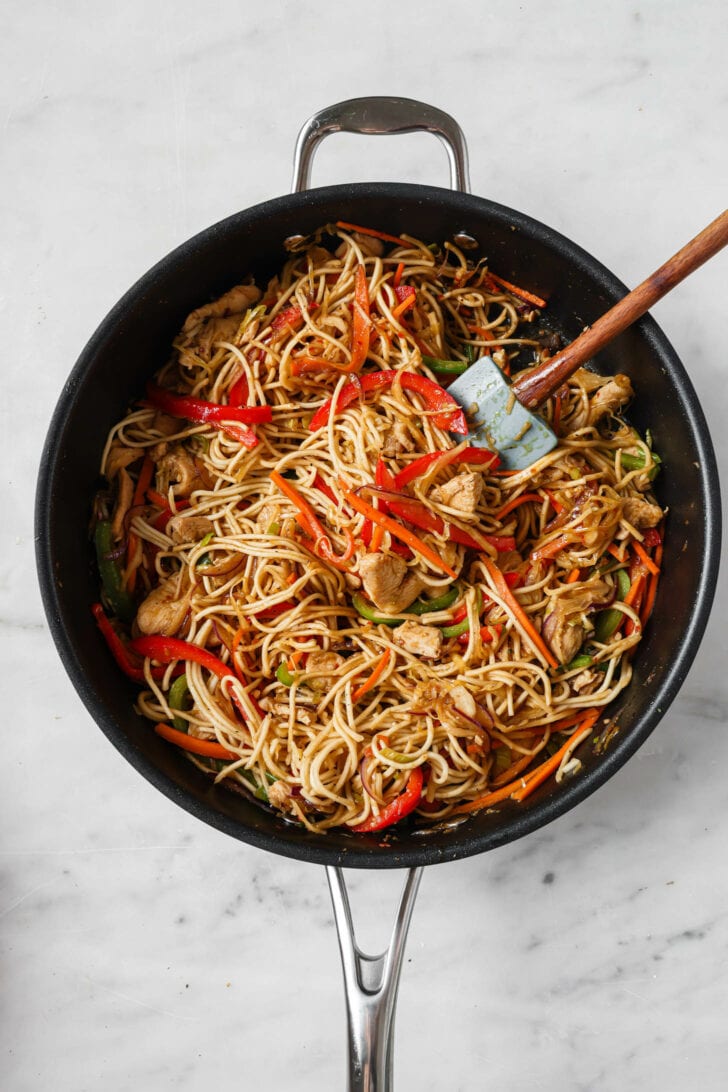
- Toss everything together (tongs help) until the sauce thickens. Garnish with green onions.
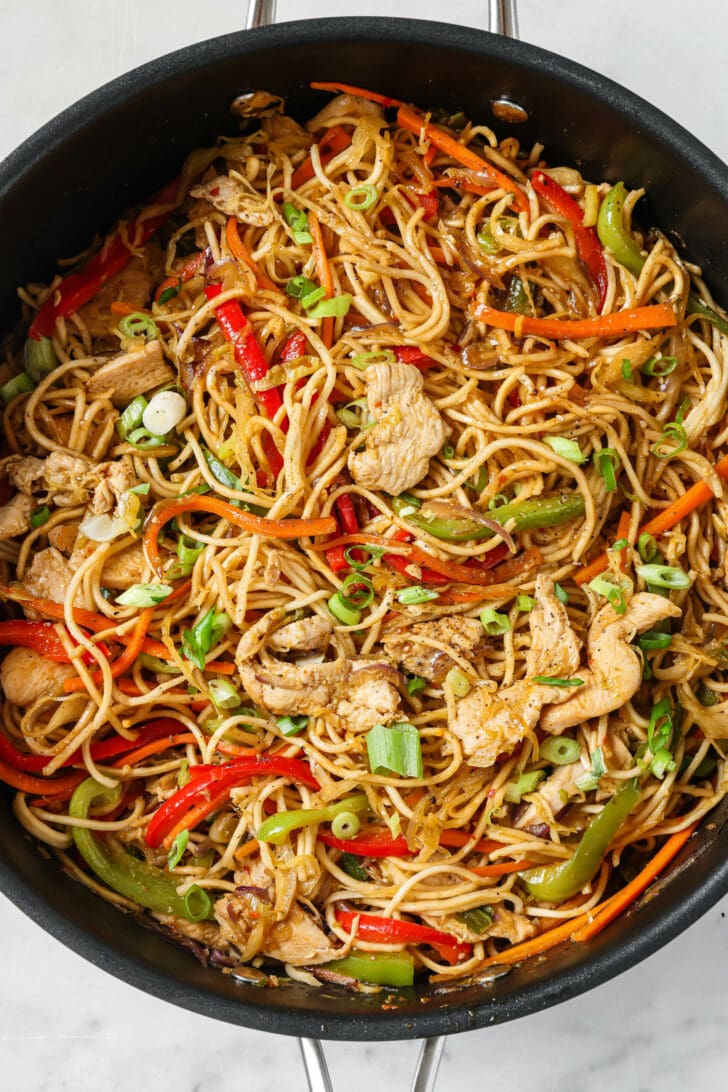
Modifications
- Make Veg Hakka Noodles: One of my testers made a vegetarian version. All she had to do was omit the chicken and proceed to sautéing the veggies. She found the salt on the borderline between just right and too much, so I’d omit the 1/8 tsp salt in the sauce, then add more to taste.
- To Double: For parties, I usually double the recipe, which is enough for a crowd. Double the ingredients but use a larger, wide-bottomed pan, similar to what you’d use to double Pulao or Biryani.
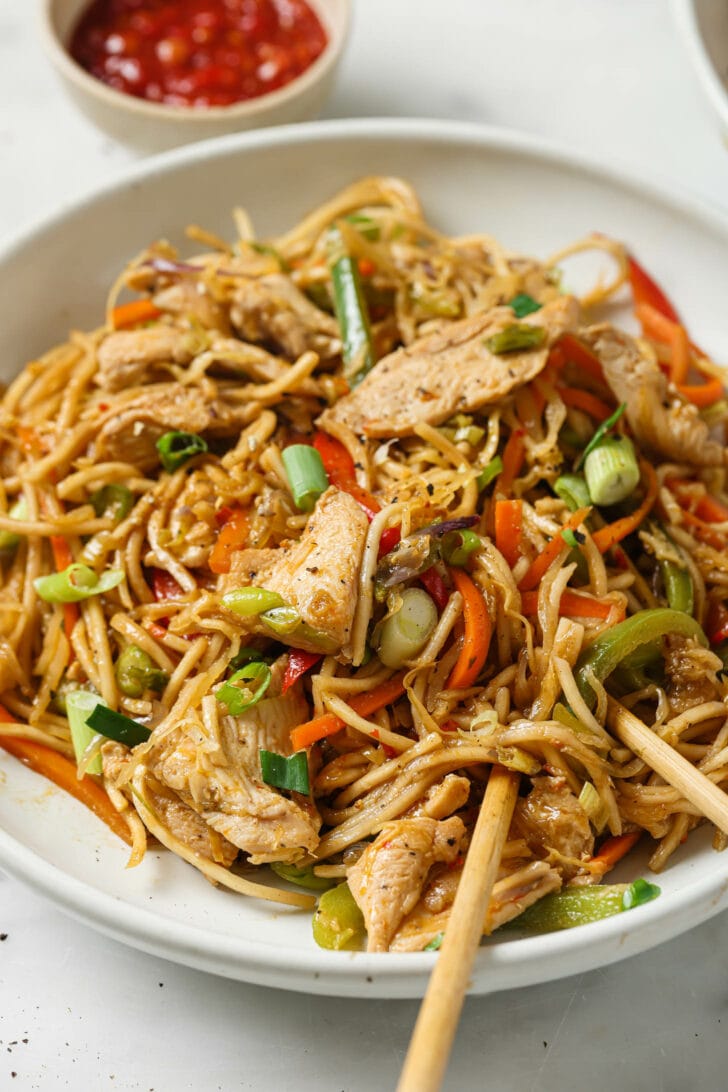
What to Serve with Hakka Noodles
Though they’re flavorful enough as-is, here are some enhancements:
- Wedges of lime
- Chili garlic sauce, sriracha, or ketchup for the kids
- Chili crisp oil or what I like to think of as ‘Tarka in a jar’
Hakka Noodles also pair well with Indo-Chinese dishes like Chicken Manchurian.
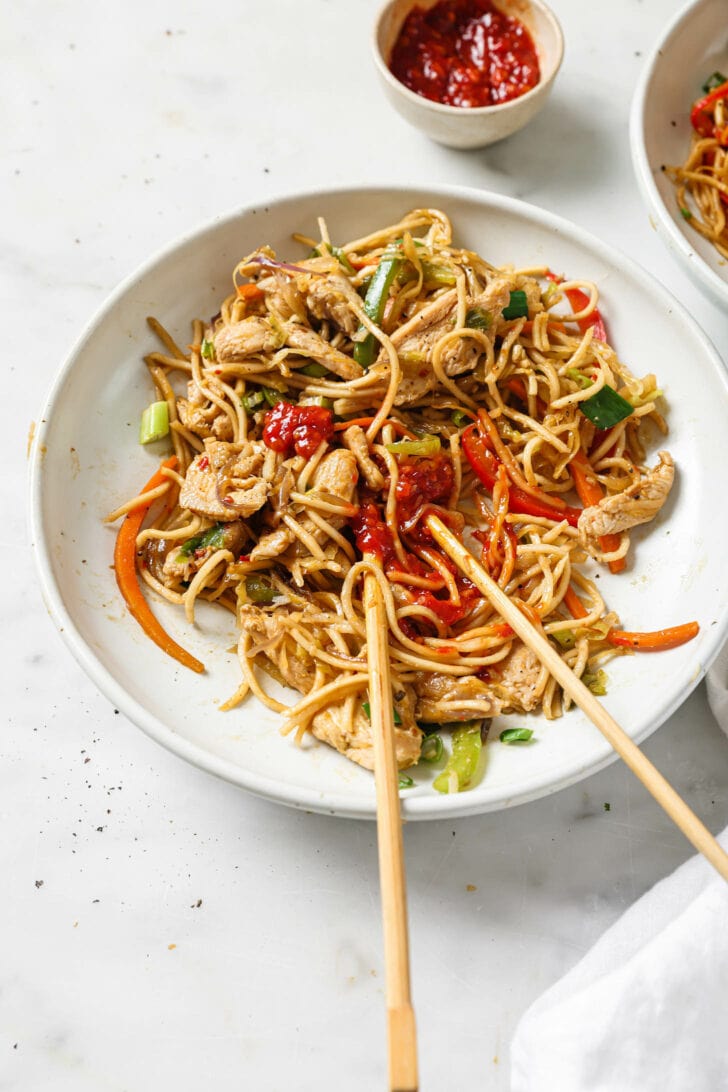
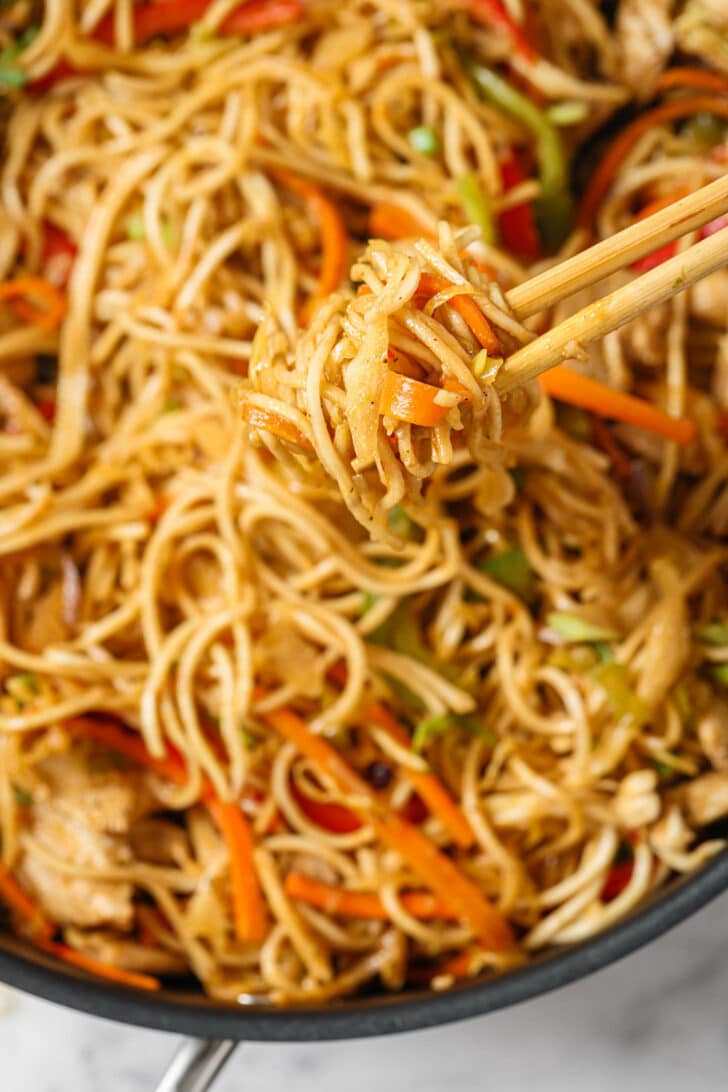
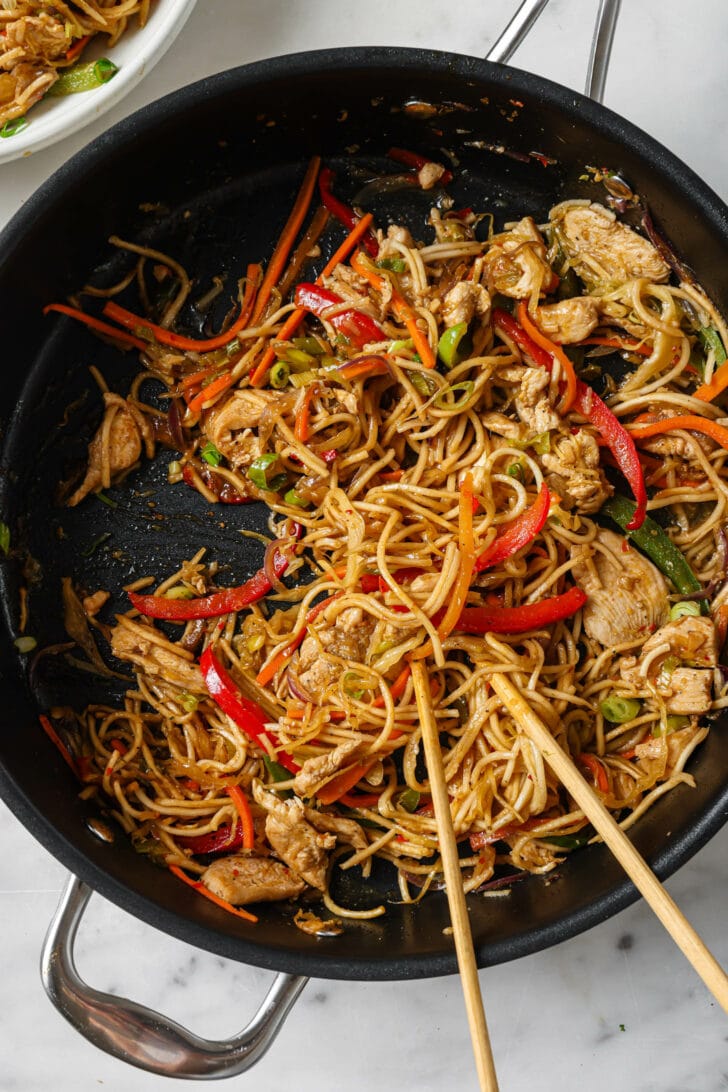
Tried this recipe? If you have a minute, please consider leaving a comment telling me how it was! If you have a photo of your dish, please feel free to upload it and share with others. If you’re on Instagram, please tag me so I can see your creations. I truly love hearing from you. Thank you!
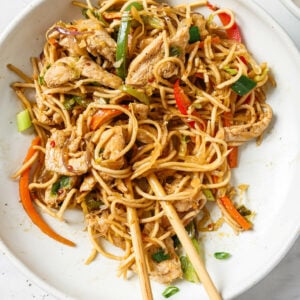
Hakka Noodles (Desi Chow Mein)
Watch the Video
Ingredients
- 210 g chicken breast or thighs, thinly sliced into small ~½” pieces -See Note 1
- 170 g (6 oz) chow mein stir-fry noodles (uncooked), or Ching’s Hakka Noodles (available at Indo-Pak grocery stores) – See Note 2
- 2 tbsp + 1 tsp neutral oil, such as grapeseed or avocado, divided
- 3 garlic cloves, minced
- ¼ inch fresh ginger, minced
- 3 (30 g) green onions, thinly sliced, reserve some green parts for garnish
- 4 oz (114 g) green cabbage (white cabbage), thinly sliced into 2” strips
- 1 (~60 g) carrot, julienned
- ½ small (~60 g) red onion, quartered & thinly sliced
- ½ (~100 g) bell pepper (capsicum), (green or red or a combo), cored, halved widthwise and cut into thin (~¼ inch) strips
- ¼ tsp sea salt
- ½ cup low-sodium vegetable stock
- lime wedges, optional – for serving
Hakka Noodles Sauce
- 1 tsp cornstarch, (or cornflour)
- 3 tbsp soy sauce
- 2 tbsp oyster sauce
- 1 tbsp rice vinegar
- 2 tsp chili garlic sauce, Lee Kum Kee, Huy Fong, or any Indian/Pakistani brands, etc.
- 1½ – 2 tsp sugar, depending on how sweet your chili garlic is
- ½ tsp toasted sesame oil
- ½-1 tsp black pepper, ½ tsp is kid-friendly, 1 tsp is spicy
- ½ tsp red chili flakes, reduce to 1/4 tsp for kids
- ⅛ tsp ground white pepper
- ¼ tsp sea salt, more to taste
Equipment
- wok or wide-bottomed pan no lid required
Instructions
- Place all ingredients listed under ‘Hakka Noodles Sauce’ in a medium bowl and whisk to combine.
- Pour 2 tbsp of sauce over the chicken and toss to marinate. Set aside while you prepare the noodles.
- Prepare noodles according to packet instructions. (I boil mine in 8-9 cups of water for 3 minutes. Then drain and rinse with cold water.) Use a tong to toss with 1 tsp of the oil to prevent them from sticking.
- Heat remaining 2 tbsp oil in a large nonstick wok or fry pan over high heat. Add garlic and ginger and stir-fry for 10-15 seconds, until golden and starting to brown. Add the chicken and stir-fry until the color changes from pink to pale, 1-2 minutes. Stir in the veggies (green onions, cabbage, carrot, onion, and bell peppers). Sprinkle in ¼ tsp sea salt. Stir-fry for 5 minutes, until the cabbage is wilted and the vegetables are tender.
- Add the noodles, sauce, and vegetable stock. Using tongs or two wooden spoons, toss everything together until combined and the sauce has dried up, 2-3 minutes. Garnish with green parts of onion and serve immediately. I like to serve with lime wedges, chili garlic, or ketchup.
Notes
-
Place the chicken in a strainer or colander and sprinkle it with baking soda. Mix well and let this mixture rest for 15-20 minutes. Rinse the chicken thoroughly, ensuring it’s completely free of any baking soda. Pat dry. Then proceed with marination.


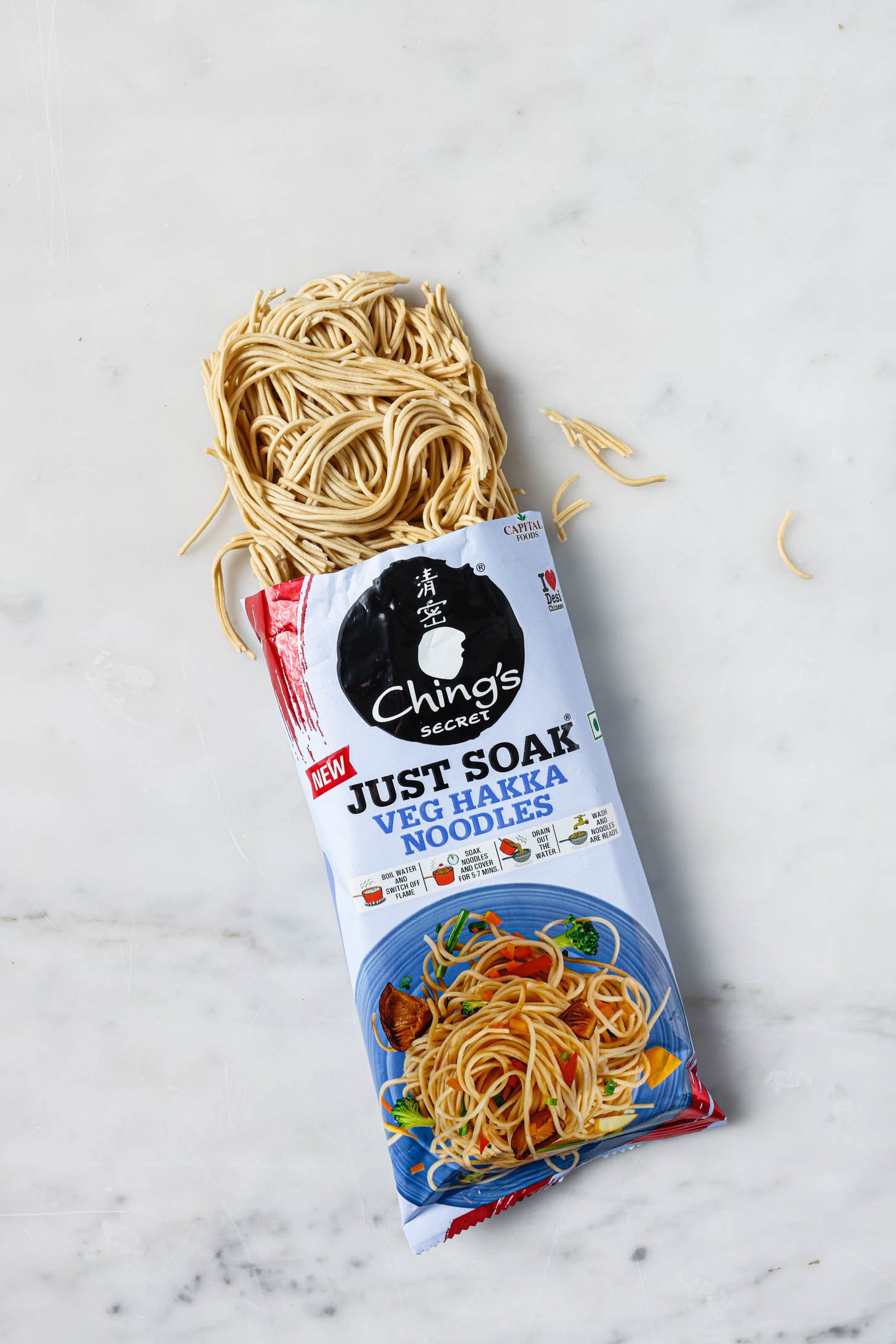
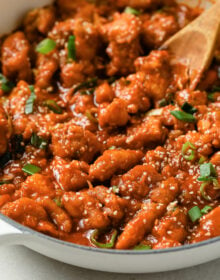
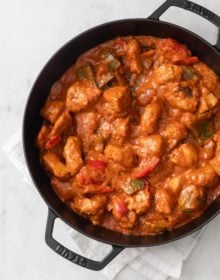
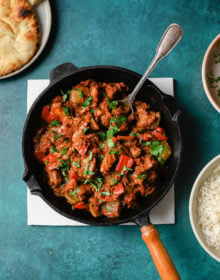

10 Comments on “Hakka Noodles (Desi Chow Mein)”
We tried this recipe and it came out perfect. I increased the spice a bit and decreased the salt to suit our taste but overall, this was delicious, simple to make and a big hit. Thank you Izzah.
That’s wonderful to hear! So glad you enjoyed the Hakka Noodles 🙂
Tried this recipe last night. It turned out fantastic. Husband (my biggest food critic) loved it
Also, the recipe is so well written that it answered my queries. I liked how alternatives and modifications were suggested.
Would definitely be making these again. 😊
Yay! We are so happy to hear you and your family enjoyed the Hakka Noodles!
Absolutely delish!
Wok was licked clean & the recipe added to my notepad! Can see myself making this a million times! So so easy & full of flavour! Both the husband & my two year old loved it
Yay! This makes us so happy to hear Amna! So glad you and your family enjoyed it 🙂
Hi Izzah,
thanks for this recipe, have been on the lookout for a desi chowmein recipe for a while, somehow I can never get it right. I will comment again once I’ve tried it, but your recipes have never steered me wrong and I’m excited to try this. One question, what can we use instead of the chilli garlic sauce? Nobody in my family eats that and we don’t buy it, we usually have all different varieties of sriracha/hot sauce lying around though
Thanks so much, Ramsha! You can sub sriracha just fine, assuming you’re okay with it being a little spicy. Otherwise just omit, it’s flavorful enough as is.
Hi ,
I want to try this and wanted to know the pan you are using
thanks
Melinda
Hi Melinda, sorry I missed this comment. In the pictures is a nonstick pan that my photographer has used. And in the video I’m using a basic induction-friendly nonstick wok I picked up at Home Goods. I’ve had a T-fal wok for many years and it’s done great. For more recommended pans, you can browse the Shop section!